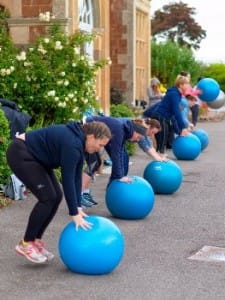Posted on 14 Nov 2018
Jen explains movement and muscles
 It occurred to me the other day that while we spend a lot of time at FitFarms holistic weight loss boot camp moving and discussing movement along with the ills of sedentary lifestyles, we rarely talk specifically about the main component responsible for it! Probably because it’s quite a vast topic and not the simplest, but I thought I’d follow that train and have an attempt at briefly explaining muscles.
It occurred to me the other day that while we spend a lot of time at FitFarms holistic weight loss boot camp moving and discussing movement along with the ills of sedentary lifestyles, we rarely talk specifically about the main component responsible for it! Probably because it’s quite a vast topic and not the simplest, but I thought I’d follow that train and have an attempt at briefly explaining muscles.
There are three types of muscles in the body, which can be divided into striated (striped) smooth and cardiac; cardiac unsurprisingly relates to the muscle forming the wall of the heart, smooth to involuntary /not consciously controlled muscles i.e. peristaltic movement of the intestines, and striated to what we consider skeletal muscle which primarily produce force and thereafter create movement. All muscles within the body share certain characteristics: the ability to contract thereby either shortening or producing tension; the ability to relax returning to resting following contraction; elasticity allowing muscle to elongate and return to rest; distensibility allowing muscle to elongate by external force without damage so long as it’s not forced beyond its limits; the ability to transmit an action potential / nerve impulse and the ability to react when stimulated.
If you’ve ever looked at a picture of skeletal muscles you may have noticed the striations on the muscles, which can give an indication as to the direction of movement that muscle moves in, some perform quite simple singular movements others multiple. The size and thickness of a muscle can also give an indication as to their particular role, those that are larger and thicker are much more capable of producing large amounts of force (i.e. legs) for greater movements, whereas long thin or very tendinous muscles may act better as pulleys (i.e. fingers). Muscles that produce movement are known as phasic and can only produce movement by pull not push, they contain mostly fast twitch fibres which are more easily fatiguable than postural muscles which mostly contain more slow twitch fibres that cope better under the sustained demand of keeping the body upright.
Movement of the body can be considered in terms of levers where the muscle dictates the direction of force, the limb moved being the load and the fulcrum altering and dictating the type of lever depending on the area of the body, but for example a bicep curl would use the biceps brachii to produce force, the load movement would be the arm flexing /bending and in this instance the fulcrum would be the elbow. Muscles producing movement are known as agonists and each agonist has an antagonist, an opposing muscle that produces an opposing movement and can prevent an agonist overproducing a movement. If anyone is interested in understanding a bit more in depth about how muscles produce movement I would recommend having a look at some of the videos on you tube on ‘sliding filament theory’.
